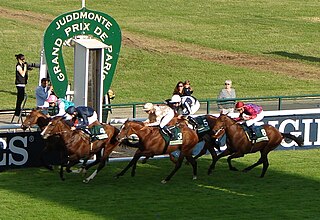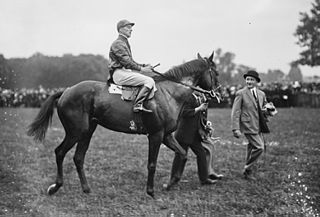This article needs additional citations for verification .(July 2023) |


A waiters' race is a race that tests the speed that a waiter can carry a loaded tray without tipping it.
This article needs additional citations for verification .(July 2023) |


A waiters' race is a race that tests the speed that a waiter can carry a loaded tray without tipping it.
It is possible to find archive footage showing a very old waiters race in Paris, London and Berlin at the beginning of the 20th century. [1] Actually, the origin of the waiters race (the "course des garçons de café"), comes from France.
At their beginning, waiters races started to be organized in order to improve the recognition of the waiter profession in Paris. [2] This is the reason why even today the event has a French Touch and organizers used to schedule races on Bastille Day for instance. [3]

Bastille Day is the common name given in English-speaking countries to the national day of France, which is celebrated on 14 July each year. In French, it is formally called the Fête nationale française ; legally it is known as le 14 juillet.

The Bastille was a fortress in Paris, known formally as the Bastille Saint-Antoine. It played an important role in the internal conflicts of France and for most of its history was used as a state prison by the kings of France. It was stormed by a crowd on 14 July 1789, in the French Revolution, becoming an important symbol for the French Republican movement. It was later demolished and replaced by the Place de la Bastille.

The Avenue des Champs-Élysées is an avenue in the 8th arrondissement of Paris, France, 1.9 kilometres (1.2 mi) long and 70 metres (230 ft) wide, running between the Place de la Concorde in the east and the Place Charles de Gaulle in the west, where the Arc de Triomphe is located. It is known for its theatres, cafés, and luxury shops, as the finish of the Tour de France cycling race, as well as for its annual Bastille Day military parade. The name is French for the Elysian Fields, the place for dead heroes in Greek mythology. It has been described as the "most beautiful avenue in the whole world".

The Place de la Bastille is a square in Paris where the Bastille prison once stood, until the storming of the Bastille and its subsequent physical destruction between 14 July 1789 and 14 July 1790 during the French Revolution. No vestige of the prison remains.

Paris–Roubaix is a one-day professional bicycle road race in northern France, starting north of Paris and finishing in Roubaix, at the border with Belgium. It is one of cycling's oldest races, and is one of the 'Monuments' or classics of the European calendar, and contributes points towards the UCI World Ranking. The most recent edition was held on 9 April 2023.

The 4th arrondissement of Paris is one of the twenty arrondissements of the capital city of France. In spoken French, this arrondissement is referred to as quatrième. Along with the 1st, 2nd and 3rd arrondissements, it is in the first sector of Paris, which maintains a single local government rather than four separate ones.

Liège–Bastogne–Liège, also known as La Doyenne, is a one-day classic cycling race in Belgium. First run in 1892, it is the oldest of the five Monuments of the European professional road cycling calendar; usually coming as the last of the spring classics. It is held annually in late April, in the Ardennes region of Belgium, from Liège to Bastogne and back.

Laurent Jalabert is a French former professional road racing cyclist, from 1989 to 2002.

The Paris Marathon is an annual marathon hosted by the city of Paris, France. It is the largest running event in France in terms of finishers and the marathon with the second-most finishers in the world, behind the New York City Marathon.

The classic cycle races are the most prestigious one-day professional road cycling races in the international calendar. Some of these events date back to the 19th century. They are normally held at roughly the same time each year. The five most revered races are often described as the cycling monuments.

The Coulée verte René-Dumont or Promenade plantée René-Dumont is a 4.7 km (2.9 mi) elevated linear park built on top of obsolete railway infrastructure in the 12th arrondissement of Paris, France. It was inaugurated in 1993.

Team TotalEnergies is a professional road bicycle racing team that competes as a UCI ProTeam in UCI Continental Circuits races, and UCI World Tour races when invited as a wild card entry. In previous years, the team was known as Brioches La Boulangère, Bonjour, Bouygues Télécom, and Bbox Bouygues Telecom and Europcar. The 2015 season was the last under the sponsorship of Europcar. The team has been sponsored by Direct Énergie since 2016.

Jean Robic was a French road racing cyclist who won the 1947 Tour de France. Robic was a professional cyclist from 1943 to 1961. His diminutive stature and appearance was encapsulated in his nickname Biquet(Kid goat). For faster, gravity-assisted descents, he collected drinking bottles ballasted with lead or mercury at the summits of mountain climbs and "cols". After fracturing his skull in 1944 he always wore a trademark leather crash helmet.

The Grand Prix de Paris is a Group 1 flat horse race in France open to three-year-old thoroughbred colts and fillies. It is run at Longchamp over a distance of 2,400 metres, and it is scheduled to take place each year in July.

The Bastille Day military parade, also known as the 14 July military parade, translation of the French name of Défilé militaire du 14 juillet, is a French military parade that has been held on the morning of 14 July each year in Paris since 1880, almost without exception. The parade passes down the Avenue des Champs-Élysées from Place Charles de Gaulle, centred around the Arc de Triomphe, to the Place de la Concorde, where the President stands, along with members of the Government, figures from the legislative branch, the Mayor of Paris, as well as foreign ambassadors to France.

The Prix Maurice de Nieuil is a Group 2 flat horse race in France open to thoroughbreds aged four years or older. It is run at Longchamp over a distance of 2,800 metres, and it is scheduled to take place each year in July.

Café philosophique is a grassroots forum for philosophical discussion, founded by philosopher Marc Sautet in Paris, France, on December 13, 1992.

Allan Peiper , is a retired Australian professional cyclist and current pro cycling team manager.

Music in the city of Paris, France, includes a variety of genres, from opera and symphonic music to musical theater, jazz, rock, rap, hip-hop, the traditional Bal-musette and gypsy jazz, and every variety of world music, particularly music from Africa and North Africa. such as the Algerian-born music known as Raï. Leading musical institutions include the Paris Opera, the Orchestre de Paris, and the Paris Conservatory, the first state music conservatory in Europe. The Cité de la Musique at La Villette is home of the new Paris Symphony Hall, the Conservatory, a museum of musical instruments, and Le Zenith, a major venue for popular music. Many of the churches in Paris have magnificent historic organs, and often host concerts. The city is also known for its music halls and clubs.
This article presents the main landmarks in the city of Paris within administrative limits, divided by its 20 arrondissements. Landmarks located in the suburbs of Paris, outside of its administrative limits, while within the metropolitan area are not included in this article.